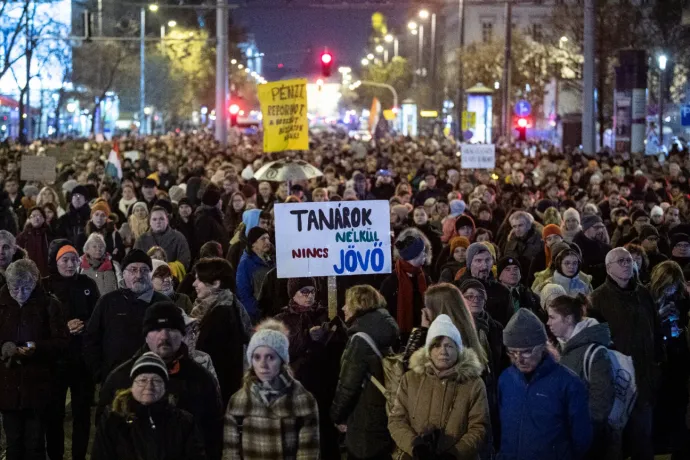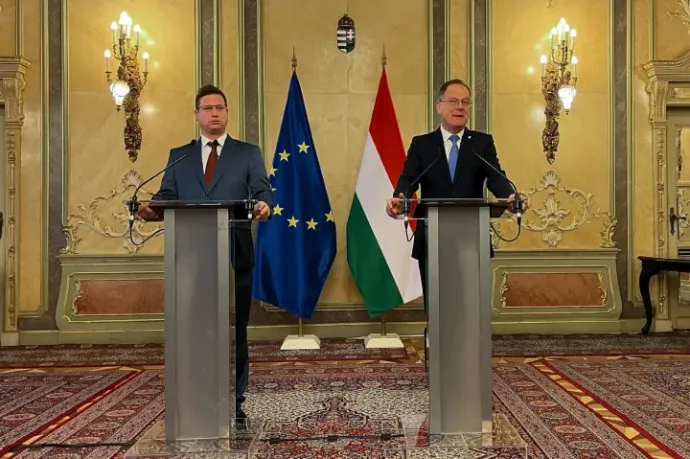EU funds on the horizon, but Hungarian teachers' pay raise still uncertain: the protests set to continue

Although an agreement was reached on Monday on EU funds for Hungary, Gergely Gulyás, Minister at the Prime Minister's Office said that several factors could still influence when teachers could receive the pay raise. According to him, the arrival of EU funds could be delayed by the European Commission imposing new conditions, in addition to the alleged undermining of the Hungarian left. But the fact is that one of the operational programmes adopted has earmarked more than 400 billion forints for supporting the teachers' careers. The trade unions say that with inflation above 20 per cent, the 20.8 per cent increase promised for next year is not enough, and that since wages are not the only problem, the protests will continue.
Following the Hungarian government's agreement on EU funds for Hungary on 12 December, teachers' salaries could increase next year. At Tuesday's press briefing, Gergely Gulyás, Minister at the Prime Minister’s Office was not clear about whether this would already happen in January. Taking over from Tibor Navracsics, he said:
"As soon as the EU funds become available, from that moment on, the teacher pay raise will be implemented."
Gulyás then added a political side-snarl, saying that the pay raise could indeed happen as early as January, if the agreement could be signed with the European Commission in December, but that "the Hungarian left and their European comrades in Brussels are working to ensure that this does not happen". As has always been the case in recent times, he repeatedly interjected that the left-wing Hungarian MEPs continue their scheming to prevent the raise in teachers' salaries, and are doing so while earning a net 6 million forints per month – as are the right-wing Fidesz MEPs, by the way.
On Tuesday, Tibor Navracsics, Minister of Regional Development, said that the agreement with the European Commission would be signed in the coming days. After this, the Commission will have to approve the operational programmes under the fast-track procedure. Later, in response to a question, Gulyás said that he did not know whether the Commission would impose any further conditions on the payment of the money or whether the funds would be opened up on 1 January.
If this happens, the January salaries paid in February could already include the increase. If the process does stall, it wouldn't be because the European Commission is being malicious, but because it is making the disbursement of the funds conditional on maximum compliance with the EU Charter of Fundamental Rights (Poland, for example, has been waiting several months for its already approved subsidies for this reason)
More than 400 billion forints for teachers' salaries
What kind of pay raise can Hungarian teachers expect? As per the government's latest, revised offer from 13 October, if an agreement is reached with the EU,
teachers' salaries will rise by 20.8% next year, 25% in 2024 and almost 30% in 2025 compared to the current base pay.
The aim is to have a gross salary of around 777,000 forints by 2025. This will bring teachers' salaries to 80 percent of the average graduate salary by 2025.
The increase would be covered by domestic and EU funds. Earlier, there was also a promise to maintain teachers' salaries at 80% of the minimum graduate wage until 2030. But the EU will only fund the increase for two years (until 2024), which means that from then on, the government will have to make the increased pay sustainable from its own resources.

How will the teachers' pay raise be financed? Teachers' wage increases will be covered by the Operational Programme for the Development of Human Resources Plus (EFOP Plusz in Hungarian), which is part of the Cohesion Fund for catching up lagging Member States.
The Cohesion Funds include five operational programmes.
Of these, the EFOP Plusz is aimed at developing the so-called teacher career model. The plan was to invest 433.34 billion forints in this.
This amount was calculated with an exchange rate of 373.9 HUF/EUR and with the current exchange rate, it amounts to 474.4 billion HUF.
The aim of the program is to make the teaching profession more attractive by increasing salaries, to keep young teachers and teachers of subjects with a severe lack of trained educators (e.g. maths, science) in their profession, and to allow for a differential recognition of quality work.
EFOP Plusz has a total budget of 1105 billion forints. 82.5 percent of this is EU funding through the European Social Fund Plus (ESF+) and the European Regional Development Fund (ERDF), and 17.5 percent is domestic money from the Hungarian budget.
It has been repeatedly reported in the news that 55 percent of the funding for three of the five operational programmes under discussion will be suspended, but the EFOP Plusz is not one of them.
Is this the success of the protests?
It is worth noting that the government initially promised teachers only a 10 percent pay raise, and the teachers started protesting this spring, while the strikes, civil disobedience activities and street demonstrations have been ongoing since September. These were already well underway when Gergely Gulyás announced that pay would be increased at a faster pace than originally planned, so this can be seen as a success for the teachers' movement, even though the government is constantly stressing that it agrees with the teachers' demands and wants to improve their wages.
It is another matter that teachers' unions have rejected this pay increase outright, which is perhaps somewhat understandable given the 21.1 percent inflation in October and the 22.5 percent inflation in November.
Even now, union representatives do not consider what we are seeing the success of almost a year's worth of teachers' protests. The teachers have several other demands on top of their wages. Erzsébet Nagy, a member of the national executive committee of the Democratic Trade Union of Teachers (PDSZ), says the money is too little anyway and that it is not a concrete proposal. Advocacy groups have long been calling for an immediate 45% pay raise. However, even if the EU money arrives at the beginning of January and teachers receive a pay raise in January, the 45% pay increase will not happen.

According to Tamás Totyik, vice-president of the Teachers' Trade Union (PSZ), another teachers' lobby group, what percentage of a salary increase teachers will receive is not what should be determined in 2023, but rather what percentage of the average graduate salary their salaries will reach. He said that this was not an irrelevant question, in view of the 20% inflation rate, among others. Totyik also said there was a lot of uncertainty about the pay raise: he said they would like to see the agreement in writing, until then they are not able to interpret it, and they would also like to know exactly how it was calculated.
"Public education has never received anything for free from this government"
Moreover, teachers, students and parents have been fighting for more than just a pay rise for teachers all year. Unions have long been communicating that low teacher pay is only part of the education system's problems. The teachers have summarised their key proposals in nine points. These include, for example, reducing the workload and achieving the right to strike.
At the recent demonstration in front of MTVA, the students promised "We will continue". And while it could be argued that many will be satisfied with the pay raise achieved by the announcement and that there will be no further protests, this is not how the unions see it.
Erzsébet Nagy said that this would not affect their decision to continue, because public education is already falling apart. In fact, she said that Gergely Gulyás' words could even be interpreted as a step backwards, because the minister did not talk about specifics. In addition, he did not mention that teachers will definitely get a certain pay raise even if the money does not arrive on time.
Nagy was referring to the 10 percent pay raise that the government had already promised the sector and which it would have originally guaranteed next year, regardless of EU funds.
According to Tamás Totyik,
public education has never received anything for free from this government, which means that the pay raise will come at a price.
He said that the whole system of public education needs to be overhauled, for example the National Curriculum needs to be modernised and the number of lessons students have must be reduced. In addition to the pay raise, the unions have several strike demands, so he said they would continue with the legal walkouts.
He said students have been taking to the streets less because teachers were not being paid, and more because there is a national shortage of teachers. They have also recognised that their further education could be at risk if, for example, a chemistry lesson is taught by a physics teacher. Tamás Totyik said that
it would be a betrayal of the students if they did not fight for the reform of the National Curriculum, as the future generation needs knowledge which is much more modern and meets the requirements of the 21st century.
This fall, as we have covered the teacher protests extensively, we also interviewed teachers about their demands and the changes they would like to see in the Hungarian education system. To find out more about why it's important how their raise is calculated, watch our linked, subtitled video!
If you found this article useful, and want to make sure you don't miss similar ones in the future, subscribe to the Telex English newsletter!